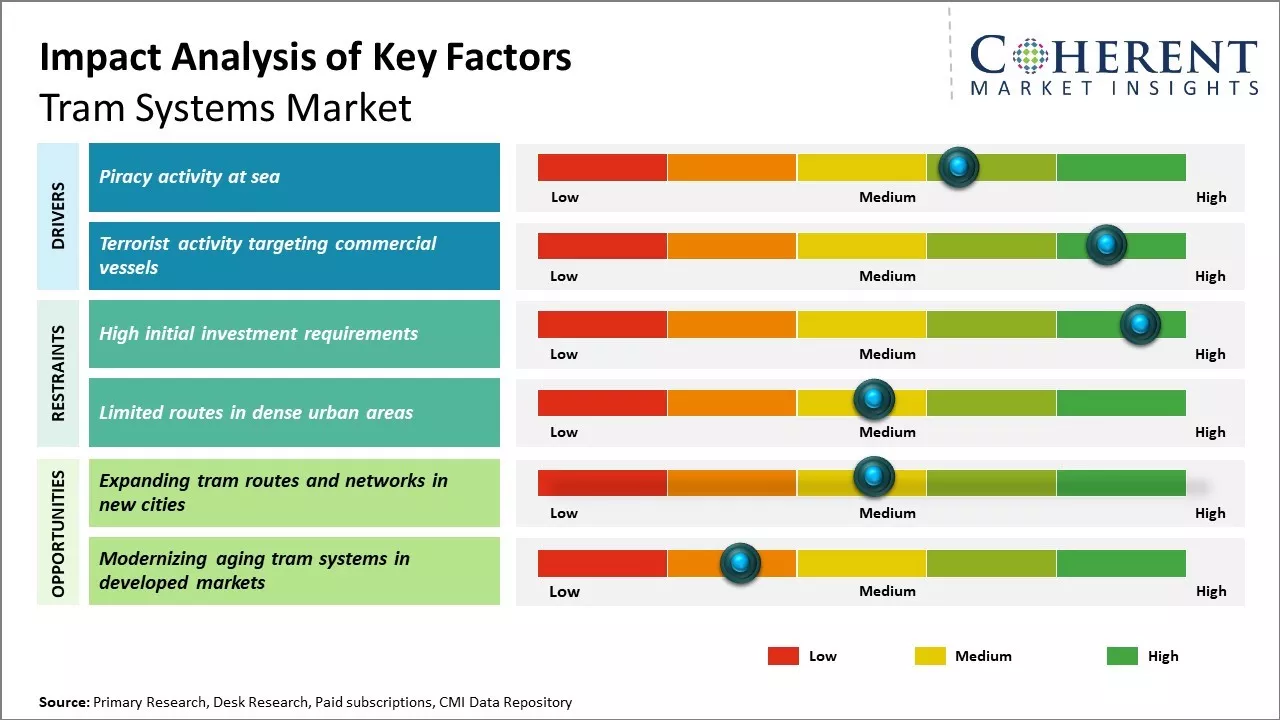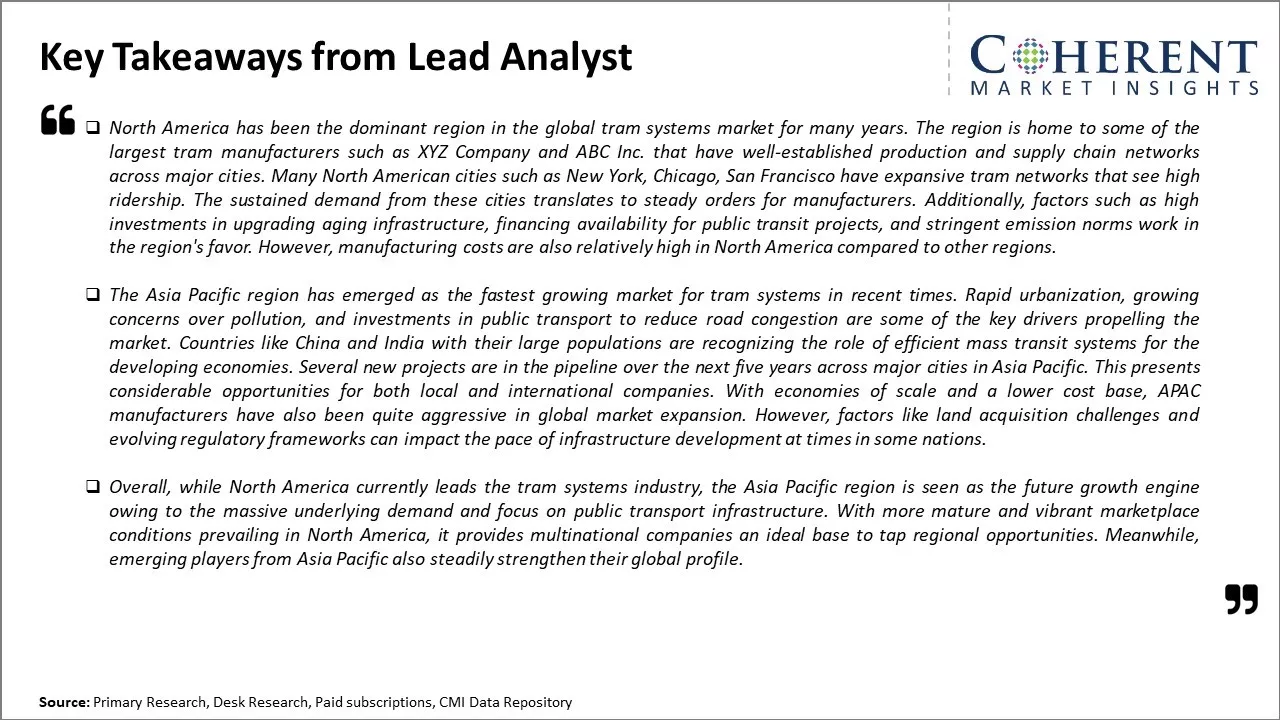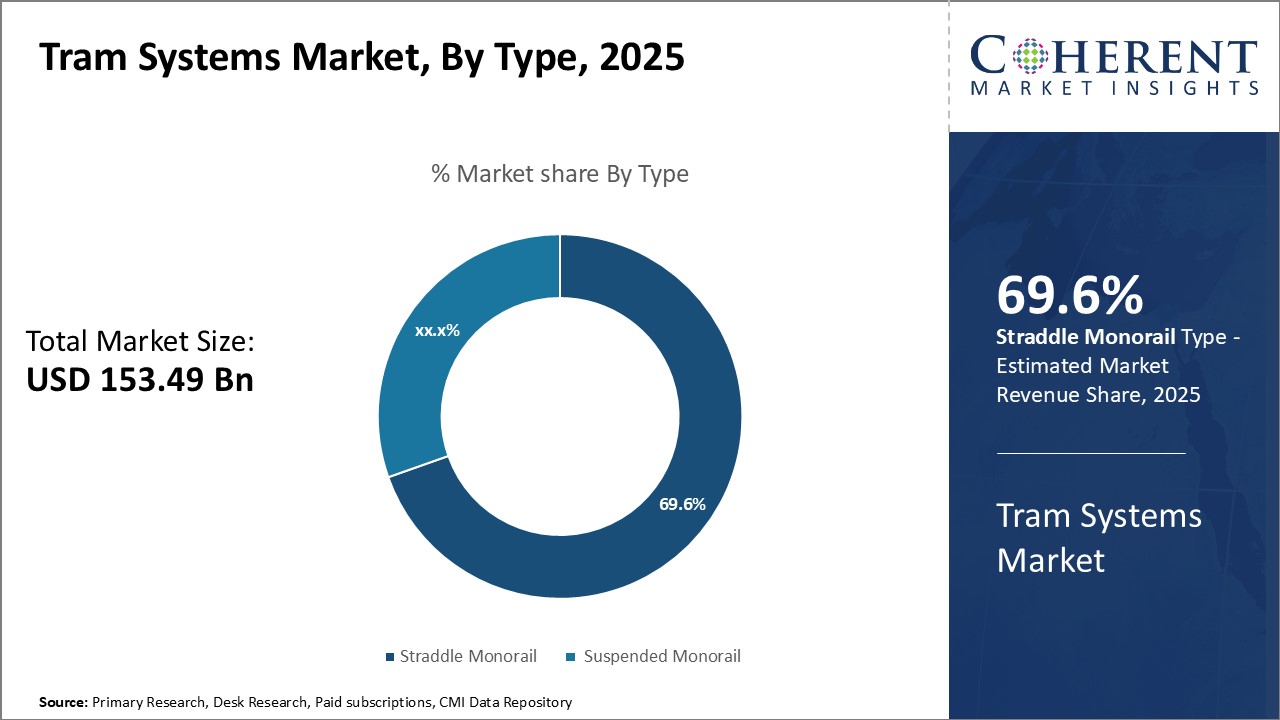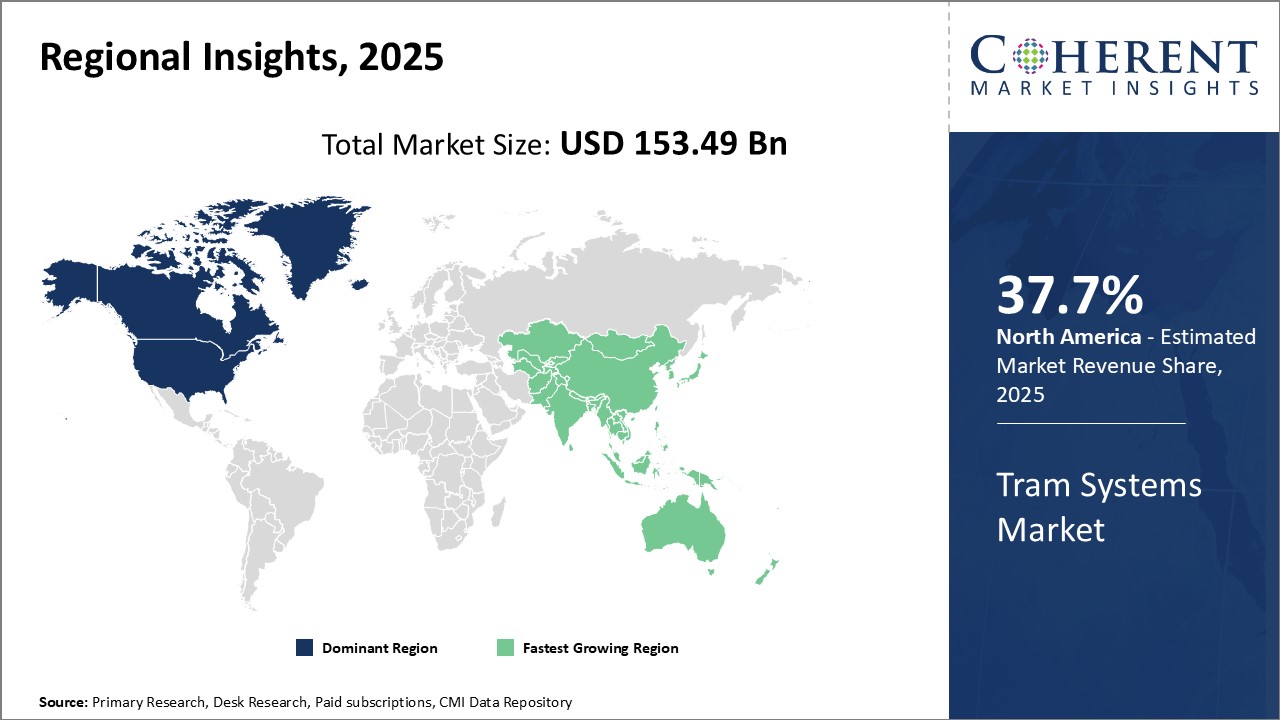The tram systems market is estimated to be valued at USD 153.49 Bn in 2025 and is expected to reach USD 345.96 Bn by 2032, growing at a compound annual growth rate (CAGR) of 12.3% from 2025 to 2032.

Discover market dynamics shaping the industry: Request sample copy
The tram systems market is expected to witness positive growth trends over the next few years. With rising urbanization and increased focus on eco-friendly public transportation solutions, many cities across the world are investing in the development of tram networks. Further, advancements in electric vehicle technology and energy storage solutions are making trams more efficient and sustainable. Many new tram projects aimed at enhancing urban connectivity and reducing traffic congestion are either in the development or planning phase. However, high initial infrastructure investment remains a key challenge for expansion of tram systems in new markets. Continued technological innovations to lower project costs and raise operating efficiencies will be critical for future market growth.
Market Drivers: Reducing Traffic Congestion
One of the primary drivers for the growth of the tram systems market is the need to reduce traffic congestion in major urban areas worldwide. Large cities have been experiencing escalating levels of traffic on roads which has led to long commuting times, wasting of productive hours, and increasing air and noise pollution. The overburdened road infrastructure is struggling to handle the exponentially rising number of vehicles, and cities are fast running out of space to expand existing roads or build new highways. Tram systems present a viable solution to ease traffic congestion by providing an alternative mode of transportation.
Trams have a much higher passenger carrying capacity compared to other transport vehicles like buses, and take up less space on roads than individual cars. A single tram can carry hundreds of people in one go, thus reducing the number of vehicles on the roads. Trams also run on designated tracks which are separate from regular traffic flows, eliminating bottlenecks. This ensures a reliable and consistent travel time for commuters. As more people shift to using trams for their daily commute needs, it substantially cuts down the vehicle traffic volumes. Cities are actively investing in expanding metro and tram networks to offer residents efficient public transportation options for intra-city travel without having to rely on private vehicles. Many urban planning authorities are promoting trams as a vital component of integrated multi-modal transport systems to ease the strain on existing road infrastructure.

Get actionable strategies to beat competition: Request sample copy
Environmental SustainabilityAnother major factor driving the adoption of tram networks globally is the push towards more environmentally sustainable transportation. With the looming threats of climate change and depletion of non-renewable energy sources, governments and citizens alike are focusing on transitioning to greener modes of travel. Trams present an eco-friendly alternative to private vehicles which are one of the biggest sources of harmful emissions and air pollution in crowded cities. A single tram can replace hundreds of gasoline or diesel-fueled cars on the road, resulting in significantly lower greenhouse gas emissions and carbon footprint. Moreover, trams are powered through overhead cables sourcing electricity from the main grid. As more cities upgrade their power infrastructure to integrate renewable energy sources, trams will progressively become even more sustainable.
Moving bulk volumes of people through electrically-powered and energy-efficient public transit like trams also reduces dependence on fossil fuels and oil imports. It supports national energy security aims.

To learn more about this report, Request sample copy
Market Challenges: High initial investment requirementsExisting infrastructure in many cities requires upgrades to integrate tram lines which is costly and often faces pushback. Additionally, there is pressure to transition to electric vehicles which trams will have to adapt to with battery or overhead technologies. Ridership declines due to increased adoption of ride-sharing services and e-scooters also threaten revenue. Younger generations appear less interested in public transit relative to past trends. Building tram networks requires extensive planning periods and may lose relevance by the time completed given rapid changes in technology and transit preferences.
Market Opportunities: Expanding tram routes and networks in new cities
Growing urban population demand solutions to traffic congestion which trams can help address. Environmental initiatives are prompting cities to invest in green mass transit networks. Adoption of autonomous driving capabilities could reduce operating costs and improve reliability.

Discover high revenue pocket segments and roadmap to it: Request sample copy
Insights, By Type - Comfort and Flexibility Drive the Straddle Monorail AdoptionIn terms of type, straddle monorail contributes the highest share of the market owing 69.6% in 2025 to its unique ability to offer passengers a comfortable and flexible travel experience compared to other monorail technologies. Straddle monorails run on elevated tracks that are wider than the trains themselves, allowing the trains to straddle both sides of the track for enhanced stability. This wide track design provides travelers with a smooth, vibration-free ride even at high speeds without the jostling felt on suspended or elevated monorails that run directly on the track. The open-air platform and wide aisle of straddle monorails maximize passenger space, making the interior feel quite roomy. This spaciousness enhances comfort during both long commutes and short trips within cities.
The wide straddle design also enables flexibility in routing. Tracks can be installed around curves and over challenging terrain like bridges more easily than other monorail types. This allows straddle monorail networks to access more destinations within urban and regional transit systems. The flexibility to modify routes opens up new connectivity options between residential areas and business districts or tourist attractions. Cities and transit agencies have favored straddle monorails for their networks due to the travel experience benefits and routing versatility compared to alternatives. New installations and system expansions continue to increase straddle monorail ridership and market share.
Insights, By Autonomy- Simplicity Drives the Demand for Semi-autonomous Tram Systems
In terms of autonomy, semi-autonomous tram systems contributes the largest share owing 47.7% in 2025 to their simplicity and adaptability compared to fully autonomous options. Semi-autonomous trams have automated driving functions like acceleration, braking, and following a designated guide path but a conductor remains onboard to intervene if needed and open doors at stations. This "driver-assisted" model provides many of the traffic flow and efficiency benefits of more advanced autonomous vehicles while avoiding the technical challenges and costs of removing conductors entirely. Transit agencies prefer the semi-autonomous approach as it utilizes existing trained personnel and operational procedures.
For passengers, the presence of a conductor enhances the travel experience by providing customer service, trip planning assistance, and a familiar human element of safety. This simplicity makes semi-autonomous trams easier for older and younger passengers to understand and trust compared to traveling in a driverless vehicle. The hybrid human-computer control also provides fallback redundancy if autonomous functions experience errors that could endanger passengers. With reliable and proven technology that offers both cost savings and a familiar service quality, semi-autonomous trams have seen rising use globally which drives their large market share over manual and fully autonomous competitors.
Insights, By Propulsion Type- Environmental Benefits and Lower Infrastructure Costs Favor Electric Monorails
In terms of propulsion type, electric monorails holds the highest market share owing 71.8% in 2025 due to their environmental and economic advantages over maglev competitors. Electric monorails are powered by overhead lines that deliver electricity to trains via pantographs, eliminating the need for onboard fuel storage and propulsion components. This simplifies vehicle design and lowers capital costs. It also removes local emissions from train operation, important for air quality in densely populated areas serviced by transit. When the electricity comes from renewable sources, electric monorails provide remarkably clean transportation.
The infrastructure for electric monorails, using elevated tracks and suspended wiring, also tends to be less expensive to build than sophisticated maglev guideways requiring precision alignment and magnetic field generators. Where routes require longer guideways or crossing significant natural barriers, electric monorail construction budgets have an edge over maglev. This makes electric monorails the preferred and most cost-effective propulsion choice for rapid transit networks in most city and regional environments. As concerns over sustainability, affordability and energy security grow; electric monorails attract more riders and see rising demand over other propulsion technologies.

Need a Different Region or Segment? Customize now
North America has been the dominant region in the global tram systems market owing 37.7% in 2025 for many years. The region is home to some of the largest tram manufacturers. that have well-established production and supply chain networks across major cities. Many North American cities such as New York, Chicago, and San Francisco have expansive tram networks that see high ridership. The sustained demand from these cities translates to steady orders for manufacturers. Additionally, factors such as high investments in upgrading aging infrastructure, financing availability for public transit projects, and stringent emission norms work in the region's favor. However, manufacturing costs are also relatively high in North America compared to other regions.
The Asia Pacific region has emerged as the fastest growing market for tram systems in recent times. Rapid urbanization, growing concerns over pollution, and investments in public transport to reduce road congestion are some of the key drivers propelling the market growth. Countries like China and India with their large populations are recognizing the role of efficient mass transit systems for the developing economies. Several new projects are in the pipeline over the next five years across major cities in Asia Pacific. This presents considerable opportunities for both local and international companies. With economies of scale and a lower cost base, Asia Pacific manufacturers have also been quite aggressive in global market expansion. However, factors like land acquisition challenges and evolving regulatory frameworks can impact the pace of infrastructure development at times in some nations.
Overall, while North America currently leads the tram systems industry, the Asia Pacific region is seen as the future growth engine owing to the massive underlying demand and focus on public transport infrastructure. With more mature and vibrant marketplace conditions prevailing in North America, it provides multinational companies an ideal base to tap regional opportunities. Meanwhile, emerging players from Asia Pacific also steadily strengthen their global profile.
Tram Systems Market Report Coverage
| Report Coverage | Details | ||
|---|---|---|---|
| Base Year: | 2024 | Market Size in 2025: | USD 153.49 Bn |
| Historical Data for: | 2020 To 2024 | Forecast Period: | 2025 To 2032 |
| Forecast Period 2025 to 2032 CAGR: | 12.3% | 2032 Value Projection: | USD 345.96 Bn |
| Geographies covered: |
|
||
| Segments covered: |
|
||
| Companies covered: |
Bombardier Corporation, CRRC Corporation Limited, Hitachi Rail, Ansaldo STS, BYD Company ltd, General Electric, Alstom S.A., Thales Group, SIEMENS AG, Mitsubishi Electric, and ABB |
||
| Growth Drivers: |
|
||
| Restraints & Challenges: |
|
||
Uncover macros and micros vetted on 75+ parameters: Get instant access to report
*Definition: The tram systems market involves the design, manufacturing, installation, and maintenance of rail-based public transportation infrastructure and vehicles within urban areas. It includes the production and sale of trams or streetcars that run on tram tracks as well as the necessary support systems like overhead wires, rails, tunnels, and stations. Companies in this market work to deliver sustainable and energy-efficient mass transit solutions to modernize public transport networks in cities worldwide and reduce road traffic congestion.
Share
Share
About Author
Ameya Thakkar is a seasoned management consultant with 9+ years of experience optimizing operations and driving growth for companies in the automotive and transportation sector. As a senior consultant at CMI, Ameya has led strategic initiatives that have delivered over $50M in cost savings and revenue gains for clients. Ameya specializes in supply chain optimization, process re-engineering, and identification of deep revenue pockets. He has deep expertise in the automotive industry, having worked with major OEMs and suppliers on complex challenges such as supplier analysis, demand analysis, competitive analysis, and Industry 4.0 implementation.
Missing comfort of reading report in your local language? Find your preferred language :
Transform your Strategy with Exclusive Trending Reports :
Frequently Asked Questions
Joining thousands of companies around the world committed to making the Excellent Business Solutions.
View All Our Clients
US Reciprocal Tax Impact Analysis On Tram Systems Market
Stay updated on tariff changes with expert insights and timely information